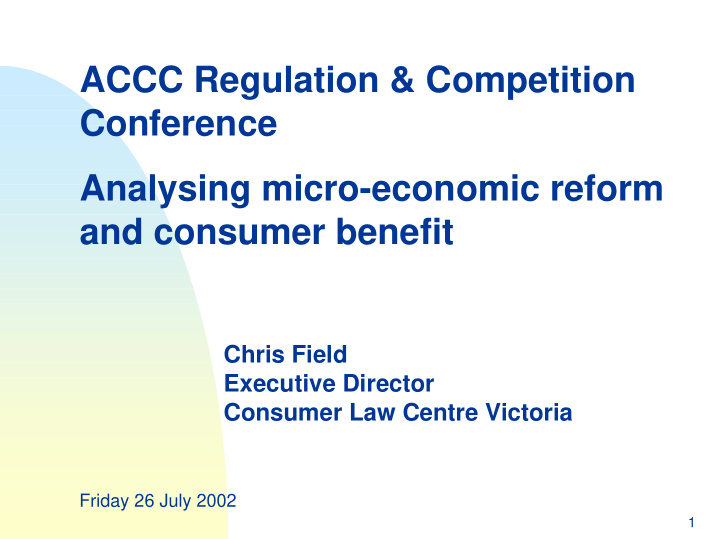



ACCC Regulation & Competition Conference Analysing micro-economic reform and consumer benefit Chris Field Executive Director Consumer Law Centre Victoria Friday 26 July 2002 1
Introduction In this presentation I will examine consumer benefits from Australia’s micro-economic reform program. In particular, I will discuss: 1. Deregulation of access to finance. 2. Introduction of private ownership and competition in the utilities, telecommunications and public transport sector. 3. Conclude by making overview comments about our economy. 2
Deregulation of access to finance • In the last five years, the four major banks have made a combined profit of more than $50 billion • Malcolm Maiden recently wrote in the Age , (“Banks were cheap-just like Telstra” 29 April 2002) that “in about a decade shares in the Commonwealth, Westpac, NAB and ANZ have doubled, doubled again, and then risen by 40 per cent, 51 per cent, 74 per cent and 75 per cent respectively. And that is capital gain only: the banks have also been producing solid dividend streams for their investors.” 3
• Compare this with the fact that: “An average of one bank branch has closed every day for the last five years” (“Small businesses paying $2.5 billion in bank fees each year,” Media Release, 9 April 2002, Financial Services Consumer Policy Centre, UNSW). • And also compare it to the massive staff losses that has been a feature of this sector of the economy. 4
• The reality is that the benefits of reform have not been distributed evenly - some consumers are much worse off. People with mortgages, professionals, people with investments don’t pay fees - the poor pay fees. Indeed, it can be argued that the poor subsidise the rich in the banking system. • The NAB has publicly suggested that it costs approximately $200 to run the average transaction account - about half pay no fees and the other half about $120. The banks therefore are cross-subsidising transactions. 5
• The perversity is the poor pay $120, the rich pay nothing. • This also excludes the fact that the poor disproportionally pay “penalty” fees. These fees, it has been estimated by the Consumers’ Federation of America, consist of about 10% cost recovery, 90% profit. • In my view, micro-economic reform in the banking industry has championed the interests of the well- off and failed vulnerable consumers. 6
The utilities market is beginning to look like the banking market - little competition between providers, exclusionary use of technology, introduction of penalty fees and generally diminished consumer protection and increased cost for low income and fixed income consumers. In the Victorian utilities market we are seeing threats to competition including significant reaggregation and almost complete consumer inertia - since the introduction of competition in February 2002 virtually no-one has shifted retailers. 7
The “Trends in Australian Infrastructure Prices 1990 -91 -2000-01” by the Productivity Commission, May 2002, reports that on average utilities bills have decreased by 1% in Melbourne. Telecommunications – A mixed outcome - price decreases in ISD/STD - price decreases in local calls - unfair contract terms - misleading advertising & selling practices - contractual penalty fees 8
- Late payment fees disproportionately impacting on the poor - Argument about declining service in rural/regional areas - Expensive duplication of infrastructure - Good governance and accountability have been threatened by privatisation 9
Victorian public transport - Government says “we aren’t responsible for many of the problems” – it was sold to the companies by the former Government. Who in this model is accountable? Ultimately, the electorate ensures that Governments are responsible. Companies responsible to their shareholders, not the public interest. 10
Along these lines, it is often suggested that “politics” inappropriately tampers with reform agendas and the perfect economic model. But it will never be otherwise – and shouldn’t be – Governments change as do Government policies because people vote in (and out) Governments – this is a feature of a civil society. 11
Conclusion - What should be the policy aspiration of a civil society regarding the delivery of essential services? Our civil society should have much broader, worthwhile objectives than simply short-term price imperatives, such as: • Sustainable, well paid employment for employees • Businesses that have a real commitment to delivering their core business in a socially responsible way Guaranteed access to essential services for people • who are currently denied such access due to their poverty alone. 12
Consumer protection for contractual terms, advertising and selling representations, privacy rights and other non-price market outcomes. Australia is an increasingly unequal society. As a matter of national shame, while the rich increase their wealth, and the country as a whole becomes wealthier, poverty in our community increases. 13
According to the ABS, there are 800,000 low paid working households in Australia. An increase in poverty has led to an increase in the number of people seeking short-term cash for survival. Of the 800,000 working poor, 41,000 sold or pawned something because they were short of money. Micro-economic reform cost-benefits analysis is actually not clear, particularly in terms of: - accountability/good governance - Employment - Efficient infrastructure development - Shared benefits/just wealth allocations 14
Tim Colebatch reported in the Age (“Study shatters egalitarian myth”) “The Age “Low-income households in Australia are the poorest of almost any comparable Western country, a landmark international comparison of income distribution reveals.” We ranked twelfth in the “league table” - below, for example, Switzerland, Germany, France, Canada and USA. Tim Colebatch also reported in the Age (“Gap between rich and poor widens”) 15
“The latest figures confirm earlier research by economists Jeff Botland, Bob Gregory and Peter Sheehan in their book Work Rich, Work Poor , showing that in the 1990s the number of middle- income jobs actually declined. All job growth was at one end or other, and average wages grew 40 per cent for managers but just 4 per cent for basic sales and service workers.” 16
Recommend
More recommend